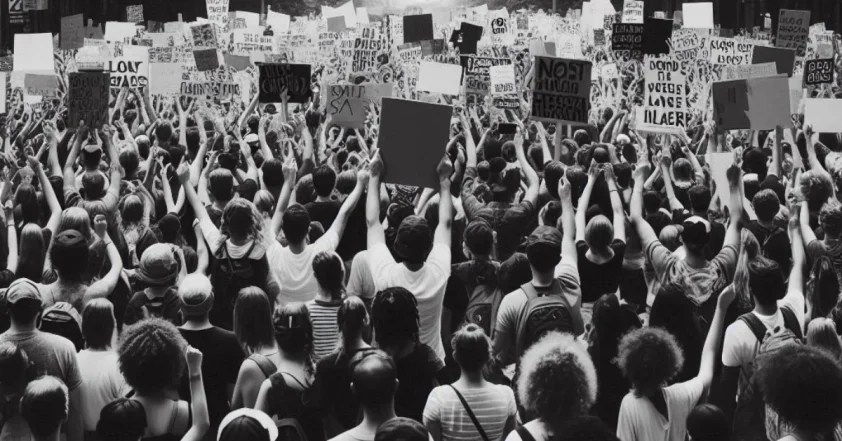
Media Headlines on Protesters vs. Statistical Reality
Welcome to this discussion. Today, I will explore how the media reports on the number of protesters compared to how statisticians analyze this information. The headlines often do not reveal the entire story.
The Media’s Take: “Thousands” Can Be Misleading
You’ve probably seen headlines like “Thousands of Protesters Take to the Streets!” Such phrases raise questions about the accuracy of these claims. Journalists might estimate there are around 7,500 protesters using reliable techniques. Do they then round it up to “nearly ten thousand” to make the headline more dramatic? It definitely seems more powerful. But, without proper context, these rounded numbers can be misleading.
Take Chicago as an example. The city’s population is around 2.7 million people. So, a protest with a few thousand participants might not be as significant as it seems. In a city that is bustling with both locals and tourists, there are countless people moving about. In that context, the 5,000 protesters might be only a tiny fraction of the overall crowd. Therefore, understanding the scale is vital when considering protesters.

Statisticians’ Approach to Protest Numbers
At Topline Statistics, I focus on context and proportion. As a statistician, I don’t just report raw numbers. I analyze what those numbers mean regarding the entire population. This approach helps clarify the impact of a protest.
For instance, if a protest in Chicago drew 5,000 people, we should consider several factors:
- Percentage of Population: This number is about 0.2% of Chicago’s population. While it might sound impressive, in a city this size represents a small slice of the community.
- Comparison with Typical Crowds: Chicago often hosts events that draw large crowds. Consequently, 5,000 attendees might not be extraordinary compared to regular events in the city and many other protesters around.
By analyzing these aspects, we gain a clearer understanding of the significance of protest numbers.
Comparing Cities: The Bigger Picture of Protests
Let’s expand our perspective by comparing Chicago to a smaller city with a population of 50,000. A protest involving 5,000 people there would be 10% of the population. This represents a much larger percentage and signifies a more substantial event that attracts more protesters proportionately.
Understanding these proportions helps put numbers into perspective. A protest may seem large in one city. However, it might be considered small in another, depending on the population size. At Topline Statistics, I utilize this approach. It provides a clearer picture of what is really happening during such events with protesters.
The Importance of Context in Data Analysis
It’s crucial to look beyond the headlines. “Thousands of Protesters” can sound dramatic but understanding what those numbers truly represent is essential. Statisticians play a key role in helping you see the full picture by analyzing context and proportions.
When you read a headline, take a moment to think about the context. What does the number really mean? Analyzing the scale of a protest compared to the population can offer deeper insights. Therefore, it is important to question the narratives presented by the media about protesters.

The Role of Statistical Methods in Reporting
In addition to understanding proportions, it is essential to recognize the statistical methods used to gather protest data. Accurate data collection is crucial for ensuring reliable information. Common methods include surveys and crowd counting techniques, which can vary in reliability.
For example, journalists may use aerial photography or estimate crowd size based on visible density. While these methods can offer helpful estimates, they are not always precise. As a result, it is important to approach these numbers with caution. Statistical methods can either enhance or undermine the credibility of protest reports on protesters.
The Need for Better Reporting Standards
Furthermore, there is a growing need for better reporting standards in media coverage of protests. Establishing consistent guidelines can help journalists show precise data. When reporters adhere to rigorous standards, they can reduce the chances of misleading their audience about protesters.
It is also important for the public to demand transparency in reporting. By seeking detailed explanations of how numbers are generated, individuals can better evaluate the claims made in headlines. Improved reporting standards benefit everyone by fostering a more informed society.
How to Interpret Protest Data
When interpreting protest data, consider several factors that can impact the understanding of the situation:
- Historical Context: Understanding past protests in the same location can provide perspective on current events. If a city regularly experiences protests, a new event with a similar number of participants may not be significant. It may not show a major shift in public sentiment.
- Geographical Differences: Different cities have distinct cultures and population densities. Therefore, what is considered a large protest in one area may not be the same in another.
- Timing and Current Events: External factors, such as political climate or recent news events, can influence protest participation. For example, a protest occurring shortly after a significant news story may attract more participants and more protesters.
By considering these factors, you can develop a more nuanced understanding of protest numbers.
Engaging with Data: A Call to Action
Next time you read a headline, remember to analyze the context behind the numbers. Understanding the statistical realities of protests can give a more precise view of the situation. It is crucial to stay informed and engage critically with the information presented about protesters.
To further your understanding, seek out data analysis resources. Websites, books, and articles can deepen your knowledge of statistics and data interpretation. By enhancing your skills in this area, you can better assess the information presented in media headlines about protesters.
Conclusion: The Power of Informed Perspectives
In conclusion, the way media reports on protesters often lacks depth. By examining the statistical reality behind the headlines, we can gain a clearer picture of what is truly happening. It is vital to consider context, proportion, and the methods used to gather data.
As consumers of information, we have a responsibility to question what we read and seek the truth behind the numbers. Engaging critically with protest data empowers us to understand the broader implications of social movements and the impact of protesters. For more insights and data analysis tips, visit Topline Statistics and stay informed.
Discover more from Topline Statistics
Subscribe to get the latest posts sent to your email.

Are you drowning in data?
Let us help! Our experts will navigate, organize, and analyze your data, bringing forth clarity and actionable recommendations.
